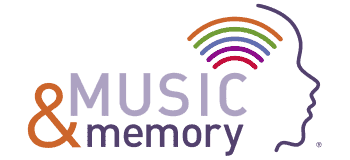We profiled Ginny Hauser, a devoted volunteer in Pullman, Washington, in 2015. Here’s an update on how MUSIC & MEMORY® is helping to ease transitions of care on the Palouse.

In 2013, when recently retired Ginny Hauser began training as a patient support volunteer at Pullman Regional Hospital, her class went to a screening of Alive Inside. That experience inspired her to ask if personal music could become part of her volunteer work with patients. The answer was yes, and MUSIC & MEMORY® on the Palouse was born the following December.
Today, Ginny is the lynchpin of a model program in southeastern Washington State that brings personal music to individuals as they transition through stages of care in the Palouse region. Participating Certified MUSIC & MEMORY® Care Organizations include Pullman Regional Hospital, serving the city of 31,000 and surrounding rural community; Avalon Care Center, a skilled nursing facility; Circles of Caring Adult Day Services; and Friends of Hospice, which supports those at end-of-life or living with chronic health conditions in private homes and adult family homes.
A music lover who plays the flute and sings in a choir for people in hospice, Ginny serves as volunteer coordinator for MUSIC & MEMORY® on the Palouse as well as a volunteer at all of the care settings, bringing personalized playlists to individuals wherever she goes. She derives deep satisfaction from seeing hundreds of people benefit from the power of personal music over the past four years. “Music is so important to me in my life, it touches my heart,” she says. “That I can help someone else by giving them music is so valuable.”
Tailoring Playlists to Individuals and Care Settings
To efficiently cover such a broad range of organizations across a rural region, Ginny works closely with staff at the various care settings. “All of our equipment is in heavy and continued use,” she notes. Each resident who enters Avalon Care Center is offered the option to have personalized music. Ginny creates the playlist that Avalon staff then introduce to the resident. She also creates tailored playlists that staff use daily for every participant at Circles of Caring.
Friends of Hospice has its own music devices and speakers, as well as a staff member who helps to set up the playlists on equipment that Ginny delivers to patients around the county. She has created Comfort Music playlists for patients who are anxious, in pain or near end-of-life, benefiting the individual, as well as family and staff. She also co-facilitates twice-monthly Rural Resources support groups for caregivers at home and helps them to develop playlists for their family members, using equipment from Friends of Hospice.
Inspired by the Power of Music to Bring Joy and Ease Pain
Watching people light up with smiles as they hear their musical favorites keeps Ginny invested in her intense volunteer commitment. She recalls the words of a longtime Avalon resident who has two music devices, one to listen to while the other charges: “Music is really soothing. It calms me down. The songs I like make me happy.”
Or the story told by an Avalon caregiver of a longtime resident: “When you put her headset on and play her music, she lights up, sings and dances in her wheelchair. She is happier, her cognition improves, and she engages with people and her surroundings. The music brings her out of her shell. She loves to hum along and sing the lyrics.”
Ginny notes that, at the request of an occupational therapist, she has created playlists for Avalon’s therapy gym that help patients feel more comfortable doing their exercises. “The tempo and beat of the music can help with gait work,” she adds. At Circles of Caring, which serves people with dementia and other cognitive conditions, staff praise the program for the way favorite music provides respite from agitation and comforts individuals who are having a rough day.
“Many of our patients are able to continue having access to their music as they move within the various care settings on the Palouse,” adds Ginny. Several families were so inspired by the experience that they asked her how to continue the music at home. At her suggestion, family members purchased a digital music device and rechargeable speaker. “I gave them each a list of their loved one’s music and talked them through how to re-create the playlist at home,” she says. In subsequent conversations, “I heard from each that their dear one was continuing to enjoy music and that they were so thankful that they could do something that would have a positive response.”
Building an Integrated Approach to Transitions of Care
For other communities considering such an integrated approach, Ginny has a few suggestions:
- Public libraries can be a key setting for Music & Memory community outreach. Depending on available resources, she notes that they might need to limit participation to hospice patients, those with terminal health diagnoses, or other long-term health situations that impact quality of life, before offering services to the general public. Libraries are ideally suited to apply for grants and donations, and to widely publicize the program. They also often have a loyal corps of volunteers.
- To provide continuity of care as an individual transitions from one care setting to another and possibly back home, social work staff can play an essential role, communicating with the next placement setting about the person’s need to access personal music. This communication would identify musical favorites and whether the person prefers a headset or speaker. Once personal music is added to the individual’s care plan, the playlist could follow them from one care setting to the next.
Founded in 2010, MUSIC & MEMORY® is a non-profit organization that brings personalized music into the lives of people with cognitive or physical conditions through digital music technology, vastly improving quality of life.
